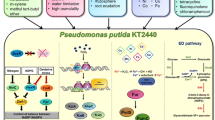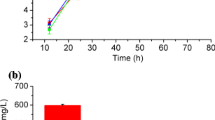Abstract
The molecular response of Pseudomonas fluorescens cells exposed to a mixture of heavy metals remains largely unknown. Here, we studied the temporal changes in the early gene expression of P. fluorescens cells exposed to three doses of a polymetallic solution over two exposure times, through the application of a customized cDNA microarray. At the lowest metal dose (MD/4), we observed a repression of the Hsp70 chaperone system, MATE and MFS transporters, TonB membrane transporter and histidine kinases, together with an overexpression of metal transport (ChaC, CopC), chemotaxis and glutamine synthetase genes. At the intermediate metal dose (MD), several amino acid transporters, a response regulator (CheY), a TonB-dependent receptor and the mutT DNA repair gene were repressed; by contrast, an overexpression of genes associated with the antioxidative stress system and the transport of chelates and sulfur was observed. Finally, at the highest metal dose (4MD), a repression of genes encoding metal ion transporters, drug resistance and alginate biosynthesis was found, together with an overexpression of genes encoding antioxidative proteins, membrane transporters, ribosomal proteins, chaperones and proteases. It was concluded that P. fluorescens cells showed, over exposure time, a highly complex molecular response when exposed to a polymetallic solution, involving mechanisms related with chemotaxis, signal transmission, membrane transport, cellular redox state, and the regulation of transcription and ribosomal activity.





Similar content being viewed by others
References
Aguilar-Barajas E, Ramírez-Díaz MI, Riveros-Rosas H, Cervantes C. Heavy metal resistance in pseudomonads. In: Ramos JL, Filloux A, editors. Pseudomonas, vol. 6: molecular microbiology, infection and biodiversity. Dordrecht: Springer; 2010. p. 255–82.
Anantharamn V, Aravind L. Evolutionary history, structural features and biochemical diversity of the NlpC/P60 superfamily of enzymes. Genome Biol. 2003;4:R11.
Andersen CL, Jensen JL, Ørntoft TF. Normalization of real-time quantitative reverse transcription-PCR data: a model-based variance estimation approach to identify genes suited for normalization, applied to bladder and colon cancer data sets. Cancer Res. 2004;64:5245–50.
Aryee M, Gutierrez-Pabello J, Kramnik I, Maiti T, Quackenbush J. An improved empirical bayes approach to estimating differential gene expression in microarray time-course data: BETR (Bayesian Estimation of Temporal Regulation). BMC Bioinform. 2009;10:409. doi:10.1186/1471-2105-10-409.
Bi S, Lai L. Bacterial chemoreceptors and chemoeffectors. Cell Mol Life Sci. 2014;1-18. doi:10.1007/s00018-014-1770-5.
Bolstad BM, Irizarry RA, Åstrand M, Speed TP. A comparison of normalization methods for high density oligonucleotide array data based on variance and bias. Bioinformatics. 2003;19:185–93.
Braz VS, Marques MV. Genes involved in cadmium resistance in Caulobacter crescentus. FEMS Microbiol Lett. 2005;251:289–95.
Butala M, Žgur-Bertok D, Busby SJW. The bacterial LexA transcriptional repressor. Cell Mol Life Sci. 2009;1:82–93.
Collet J-F, Bardwell JCA. Oxidative protein folding in bacteria. Mol Microbiol. 2002;44:1–8.
Dubern J-F, Lagendijk EL, Lugtenberg BJJ, Bloemberg GV. The heat shock genes dnaK, dnaJ and grpE are involved in regulation of putisolvin biosynthesis in Pseudomonas putida PCL1445. J Bacteriol. 2005;187:5967–76.
Forchhammer K. Glutamine signalling in bacteria. Front Biosci. 2007;12:358–70.
Gadd GM. Metals, minerals and microbes: geomicrobiology and bioremediation. Microbiology. 2010;156:609–43.
Gómez-Sagasti MT, Becerril JM, Martín I, Epelde L, Garbisu C. cDNA microarray assessment of early gene expression profiles in Escherichia coli cells exposed to a mixture of heavy metals. Cell Biol Toxicol. 2014;30:207–32.
Hu P, Brodie EL, Suzuki Y, McAdams HH, Andersen GL. Whole-genome transcriptional analysis of heavy metal stresses in Caulobacter crescentus. J Bacteriol. 2005;187:8437–49.
Igarashi K, Kashiwagi K. Characteristics of cellular polyamine transport in prokaryotes and eukaryotes. Plant Physiol Biochem. 2010;48:506–12.
Jain S, Bhatt A. Proteomic analysis of diversified extremophilic strains of Pseudomonas in the presence of cadmium. Agric Res. 2013;2:354–9.
Kiliç NK, Stensballe A, Otzen DE, Dönmez G. Proteomic changes in response to chromium (VI) toxicity in Pseudomonas aeruginosa. Bioresour Technol. 2010;7:2134–40.
Krell T, Lacal J, Busch A, Silva-Jiménez H, Guazzaroni M-E, Ramos JL. Bacterial sensor kinases: diversity in the recognition of environmental signals. Annu Rev Microbiol. 2010;64:539–59.
Kumar S, Floyd JT, He G, Varela MF. Bacterial antimicrobial efflux pumps of the MFS and MATE transporter families: a review. Recent Res Devel Antimicrob Agents Chemother. 2013;7:1–21.
Lee JH, Kim YG, Cho MH, Lee J. ZnO nanoparticles inhibit Pseudomonas aeruginosa biofilm formation and virulence factor production. Microbiol Res. 2014;169:888–96.
Lemire J, Mailloux R, Auger C, Whalen D, Appanna VD. Pseudomonas fluorescens orchestrates a fine metabolic-balancing act to counter aluminium toxicity. Environ Microbiol. 2010;12:1384–90.
Leonhardt N, Kwak JM, Robert N, Waner D, Leonhardt G, Schroeder JI. Microarray expression analyses of Arabidopsis guard cells and isolation of a recessive abscisic acid hypersensitive protein phosphatase 2C mutant. Plant Cell. 2004;16:596–615.
Li K, Pidatala RR, Ramakrishna W. Mutational, proteomic and metabolomic analysis of a plant growth promoting copper-resistant Pseudomonas spp. FEMS Microbiol Lett. 2012;335:140–8.
Llamas MA, Bitter W. Cell-surface signalling in Pseudomonas. In: Ramos J-L, Filloux A, editors. Pseudomonas. volume 6: molecular microbiology, infection and biodiversity. Netherlands: Springer; 2010. p. 59–95.
Lubelski J, Konings WN, Driessen AJM. Distribution and physiology of ABC-type transporters contributing to multidrug resistance in bacteria. Microbiol Mol Biol Rev. 2007;71:463–76.
Ma Z, Jacobsen FE, Giedroc DP. Metal transporters and metal sensors: how coordination chemistry controls bacterial metal homeostasis. Chem Rev. 2009;109:4644–81.
Martínez JL, Sánchez MB, Martínez-Solano L, Hernández A, Garmendia L, Fajardo A, et al. Functional role of bacterial multidrug efflux pumps in microbial natural ecosystems. FEMS Microbiol Rev. 2009;33:430–49.
Mascher T, Helmann JD, Under G. Stimulus perception in bacterial signal-transducting histidine kinases. Microbiol Mol Biol Rev. 2006;70:910–38.
Miller CD, Pettee B, Zhang C, Pabst M, McLean JE, Anderson AJ. Copper and cadmium: responses in Pseudomonas putida KT2440. Lett Appl Microbiol. 2009;49:775–83.
Moore CM, Gaballa A, Hui M, Ye RW, Helmann JD. Genetic and physiological responses of Bacillus subtilis to metal ion stress. Mol Microbiol. 2005;57:27–40.
Morey JS, Ryan JC, Van Dolah FM. Microarray validation: factors influencing correlation between oligonucleotide microarrays and real-time PCR. Biol Proced Online. 2006;8:175–93.
Nies DH. Efflux-mediated heavy metal resistance in prokaryotes. FEMS Microbiol Rev. 2003;27:313–39.
Omote H, Hiasa M, Matsumoto T, Otsuka M, Moriyama Y. The MATE proteins as fundamental transporters of metabolic and xenobiotic organic cations. Trends Pharmacol Sci. 2006;27:587–93.
Pagès D, Sánchez L, Conrad S, Gidrol X, Fekete A, Schmitt-Kopplin P, et al. Exploration of intraclonal adaptation mechanisms of Pseudomonas brassicacearum facing cadmium toxicity. Environ Microbiol. 2007;9:2820–35.
Pfaffl MW. Relative quantification. real time qPCR. New York: Taylor & Francis Group; 2006. p. 63–82.
Poirier I, Kuhn L, Caplat C, Hammann P, Bertrand M. The effect of cold stress on the proteome of the marine bacterium Pseudomonas fluorescens BA3SM1 and its ability to cope with metal excess. Aquat Toxicol. 2014;157:120–33.
Potvin E, Sanschagrin F, Levesque RC. Sigma factors in Pseudomonas aeruginosa. FEMS Microbiol Rev. 2007;32:38–55.
Reva ON, Weinel C, Weinel M, Böhm K, Stjepandic D, Hoheisel JD, et al. Functional genomics of stress response in Pseudomonas putida KT2440. J Bacteriol. 2006;188:4079–92.
Romero P, Karp P. PseudoCyc, a pathway-genome database for Pseudomonas aeruginosa. J Mol Microbiol Biotechnol. 2003;5:230–9.
Rozen S, Skaletsky H. Primer3 on the WWW for general users and for biologist programmers. Methods Mol Biol. 2000;132:365–86.
Saha R, Saha N, Donofrio RS, Bestervelt LL. Microbial siderophores: a mini review. J Basic Microbiol. 2013;53:303–17.
Sarma B, Acharya C, Joshi SR. Pseudomonads: a versatile bacterial group exhibiting dual resistance to metals and antibiotics. Afr J Microbiol Res. 2010;4:2828–35.
Schalk IJ, Hannauer M, Braud A. New roles for bacterial siderophores in metal transport and tolerance. Environ Microbiol. 2011;13:2844–54.
Schmittgen TD, Livak KJ. Analyzing real-time PCR data by the comparative CT method. Nat Protoc. 2008;3:1101–8.
Sharma S, Sundaram CS, Luthra PM, Singh Y, Sirdeshmukh R, Gade WN. Role of proteins in resistance mechanism of Pseudomonas fluorescens against heavy metal induced stress with proteomics approach. J Biotechnol. 2006;126:374–82.
Sharma SK, Goloubinoff P, Christen P. Heavy metal ions are potent inhibitors of protein folding. Biochem Biophys Res Commun. 2008;372:341–5.
Silver S, Phung LT. A bacterial view of the periodic table: genes and proteins for toxic inorganic ions. J Ind Microbiol Biot. 2005;32:587–605.
Soukas A, Cohen P, Socci ND, Friedman JM. Leptin-specific patterns of gene expression in white adipose tissue. Genes Dev. 2000;14:963–80.
Teitzel GM, Geddie A, De Long SK, Kiristis MJ, Whiteley M, Parsek MR. Survival and growth in the presence of elevated copper: transcriptional profiling of copper-stressed Pseudomonas aeruginosa†. J Bacteriol. 2006;188:7242–56.
Tenaillon O, Skurnik D, Picard B, Denamur E. The population genetics of commensal Escherichia coli. Nat Rev Microbiol. 2010;8:207–17.
Thaden JT, Lory S, Gardner TS. Quorum-sensing regulation of a copper toxicity system in Pseudomonas aeruginosa. J Bacteriol. 2010;192:2557–68.
Vandesompele J, De Preter K, Pattyn F, Poppe B, Van Roy N, De Paene A, et al. Accurate normalization of real-time quantitative RT-PCR data by geometric averaging of multiple internal control genes. Genome Biol. 2002;3:research0034.0031-11.
Varivarn K, Champa LA, Silby MW, Robleto EA. Colonization strategies of Pseudomonas fluorescens Pf0-1: activation of soil-specific genes important for diverse and specific environments. BMC Microbiol. 2013;13:92.
Vetting MW, de Carvalho LPS, Yu M, Hegde SS, Magnet S, Roderick SL, et al. Structure and functions of the GNAT superfamily of acetyltransferases. Arch Biochem Biophys. 2005;1:212–26.
Wasi S, Jeelani G, Ahmad M. Biochemical characterization of a multiple heavy metal, pesticides and phenol resistant Pseudomonas fluorescens strain. Chemosphere. 2008;71:1348–55.
Wasi S, Tabrez S, Ahmad M. Use of Pseudomonas spp. for the bioremediation of environmental pollutants: a review. Environ Monit Assess. 2013;185:8147–55.
Winsor GL, Lam DK, Fleming L, Lo R, Whiteside MD, Yu NY, et al. Pseudomonas genome database: improved comparative analysis and population genomics capability for Pseudomonas genomes. Nucleic Acids Res. 2011;39(Database issue):D596–600.
Yeung KY, Haynor DR, Ruzzo WL. Validating clustering for gene expression data. Bioinformatics. 2001;17:309–18.
Zhou J, Rudd KE. EcoGene 3.0. Nucleic Acids Res. 2013;41:D613–24.
Acknowledgments
This work has been financially supported by 7/12/TK/2009/3 LURCHIP (Biscay County Council) and MINECO AGL2012-39715-CO3-01/02 projects. M.T. Gómez-Sagasti is the recipient of a Fellowship for Recent Doctors, University of the Basque Country. Technical support by Javier Etxebarria and Amaia García from GAIKER is gratefully acknowledged.
Author information
Authors and Affiliations
Corresponding author
Rights and permissions
About this article
Cite this article
Gómez-Sagasti, M.T., Becerril, J.M., Epelde, L. et al. Early gene expression in Pseudomonas fluorescens exposed to a polymetallic solution. Cell Biol Toxicol 31, 39–81 (2015). https://doi.org/10.1007/s10565-015-9294-9
Received:
Accepted:
Published:
Issue Date:
DOI: https://doi.org/10.1007/s10565-015-9294-9




